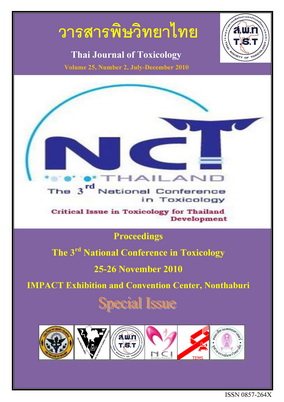Detoxification of Cadmium Induced Renal and Hepatic Injuries in Rats by Thunbergia laurifolia Lindl. Leaf Extract
Main Article Content
Abstract
Cadmium can damage kidney and liver cells. Thunbergia laurifolia Lindl. is a herb used as an antidote for several poisonous agents in Thai traditional medicine. This study tested the effectiveness of the herb to prevent renal and hepatic injuries induced by cadmium chloride (CdCl2). Male Wistar rats were fed 125 mg/kg of the leaf extract before and after administration of 1.2 mg/kg of CdCl2 solution subcutaneously for 5 days/week for 4 weeks. Blood and urinary samples were collected for quantification of cadmium concentrations using graphite furnace atomic absorption spectrometer. The kidneys and livers were removed and examined for histopathological changes. The results showed that the leaf extract given to rats orally did not prevent mortality in rats exposed to cadmium. However, abnormal appearance and behaviour was less in rats fed the leaf extract prior to cadmium exposure than in those fed leaf extract after cadmium exposure. The constituents of the extract were identified as aromatic, hexyl and glucoside compounds by nuclear magnetic resonance spectroscopy. The T. laurifolia leaf extract may reduce some effects of cadmium toxicity, but this conclusion is uncertain due to the high mortality rate of the rats in these experiments. Future trials will use a lower cadmium dosage and alternative routes of treating the animals with the leaf extract.


